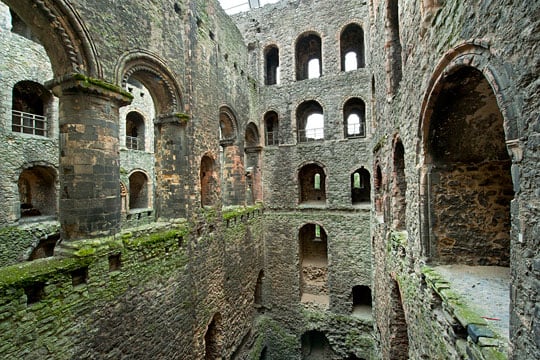Significance of Rochester Castle
Rochester Castle is one of the best-preserved and finest examples of Norman architecture in England. Its historical significance lies in its role as a strategic fortification in the conflict between early medieval kings and nobility. Facing the equally imposing medieval Rochester Cathedral, it also remains a potent representation of secular versus ecclesiastical power.

Keep
The keep of Rochester Castle is an architectural masterpiece.[1] It is the tallest surviving great tower of its type in Europe, and was almost certainly among the tallest at the time of its construction.
The rooms on the second (principal) floor were made more architecturally imposing by a mezzanine gallery in the thickness of the outer walls, a feature also seen at the baronial castle at Hedingham, Essex, and the royal castle at Norwich. The architectural detailing is generally simpler than that of contemporary great cathedrals and abbeys, but even in its present mutilated state it shows clearly that the architecture of Norman castles could be extremely sophisticated.
The survival of doors, fireplaces and windows, together with evidence for floors and partitions, allows unusually good scope for inferring the historic patterns of circulation around the building and the functions of individual floors and rooms.
Crown and Church
The close juxtaposition of castle and cathedral in Rochester is a powerful symbol of the twin poles of authority in medieval society: the secular power of the Crown and nobility, and the ecclesiastical power of bishops and monastic orders. The ensemble at Rochester can be compared with that in other cities in England, notably Lincoln, and continental Europe.
It can be argued that the presence of the castle influenced unusual elements of the cathedral’s layout, such as the location of the monks’ cloister south of the cathedral chancel. The more conventional position, south of the nave, would have been directly overlooked by the castle. It was instead occupied by the bishop’s palace, the residence of the principal ecclesiastical power.[2]
The Sieges of 1215 and 1264
The siege and capture of the castle by King John in 1215 shocked contemporaries and, thanks to detailed chronicle descriptions, has remained one of the best-known such episodes in English history. The conventional interpretation of the great towers, or keeps, of castles as buildings of ‘last resort’ during sieges owes much to the story of Rochester, including the use of the spine wall as a final barrier by defenders.[3]
The siege of 1264, though less widely known, is extremely well documented in chronicles and Exchequer accounts, which even allow modern researchers to reconstruct the consumption of food by the garrison as events progressed.[4] The 1264 siege was arguably the more destructive event, from which the castle never entirely recovered.
Artistic and Literary Associations
The ruined keep has been the subject of artistic depiction and recording in literature, notably by Charles Dickens in the 19th century. The building seems not to have been widely regarded as a ‘romantic ruin’. Rather, the overpowering scale and height of the tower inspired meditation on the insignificance of the modern individual and on the destructive power of time.[5]
The Castle as Public Amenity
Since the 19th century the Castle Gardens in the former bailey, once heavily planted and punctuated by monuments, but now consisting of lawns, have been a valued amenity for the citizens of Rochester.
Footnotes
1. JAA Goodall, The English Castle (New Haven and London, 2011), 105–19.
2. T Tatton-Brown, ‘The topography and buildings of medieval Rochester’, in Medieval Art, Architecture and Archaeology at Rochester, ed T Ayers and T Tatton-Brown, British Archaeological Association Conference Transactions 28 (Leeds, 2006), 22–37. The specific point about the location of the cloister is made by JS McNeill, ‘The east cloister range of the priory’, in ibid, 181–204, especially 185–6.
3. For example P Dixon, ‘The myth of the keep’, in The Seigneurial Residence in Western Europe, AD 800–1600, ed G Meirion-Jones and E Impey (Oxford, 2002), 9–14.
4. The National Archives (TNA), E101/333/3.
5. C Dickens, ‘One man in a dockyard’, Household Words, 3/76 (entry for Saturday 6 September 1851), 553 (accessed 16 May 2013).